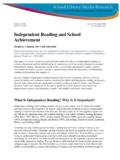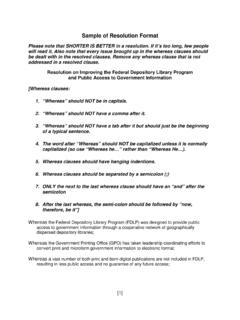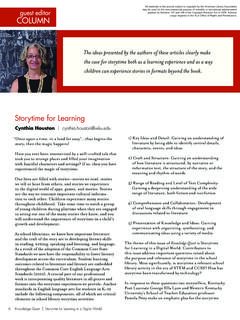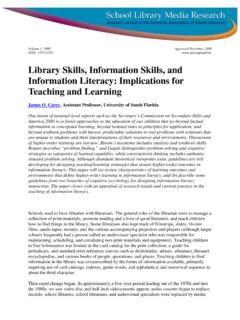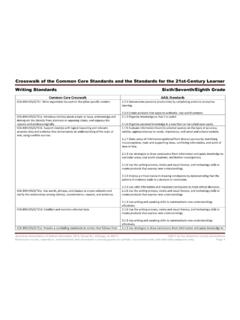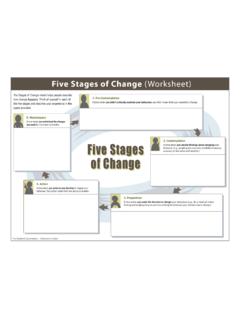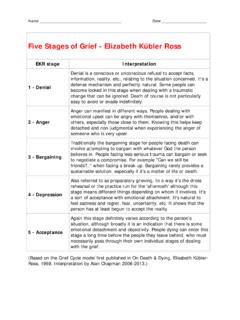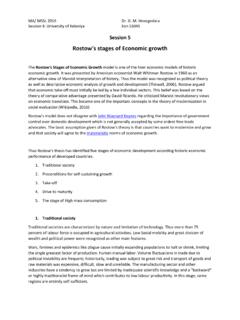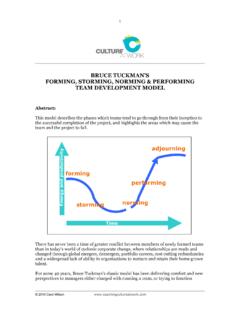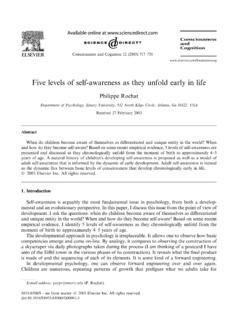Transcription of The Assault Cycle - American Library Association
1 PLA Webinar Violence Prevention in the Public Library The Assault Cycle and Verbal Diffusion Handout Kenneth Wolf, , Marilyn Knight, MSW 2014 Incident Management Team 1 The Assault Cycle 1. The Triggering Events - Occurrence perceived by the individual as a serious threat to him/her. TTWWOO TTYYPPEESS:: Fear Inducing Events Give the person the perception he/she is under threat or about to lose something of value. Frustrating Circumstances Give the person the idea that his/her efforts or demands have been useless. 2. Escalation Phase - Person s body and mind prepare for a fight. He/She may respond physically or taunt the perceived threat, if it is a person. 3. Crisis Point - Aggressor explodes into violent acts against the threat.
2 4. Recovery Phase - Aggressor s body relaxes and mind decreases its vigilance. The confrontation is seen to be over, even if temporary. 5. Post-Crisis Phase - While aggressor tries to return to stable base level, he/she often experiences fatigue, depression, and guilt. The Triggering Event(s) Escalation Crisis Point Recovery Post-Crisis Depression PLA Webinar Violence Prevention in the Public Library The Assault Cycle and Verbal Diffusion Handout Kenneth Wolf, , Marilyn Knight, MSW 2014 Incident Management Team 2 Steps in Verbally Defusing Potential Violence I. OBSERVE THE SITUATION/READ THE CLUES II. DETERMINE YOUR SAFETY A. Is the person getting calmer or getting more upset? B. Can you be with this person or group and be reasonably safe?
3 C. Should you call security, the police, or should you escape? III. LEADER BEHAVIOR A. Facial Features Relaxed Serious (not stern) looks Good eye contact (not staring) Attentive, focused on the person B. Body Stance Standing diagonally, about 3-5 feet away Hands down to the sides, palms facing person Weight equally balanced on both feet C. Voice Tone Calm, quiet, remember to breathe Slow paced Sound confident that you can help them D. Attitude I have time for you You are an important person Together we can make things better Let s talk about it E. Words Being Said I d like to see if we can work this out Please tell me more about what happened Tell me about how you have been unfairly treated Why do you PLA Webinar Violence Prevention in the Public Library The Assault Cycle and Verbal Diffusion Handout Kenneth Wolf, , Marilyn Knight.
4 MSW 2014 Incident Management Team 3 Words Being Said continued Let s go to a place where we can talk more privately Listen to the story without changing the subject/interrupting Clarify those things you don t understand Listen on two levels-the meaning of the words and the emotional meaning Use their words or similar words when you talk about the situation Use words that show you understand how he/she might be feeling ( You must have been feeling like what you said didn t mean anything. ) Be willing to hear a differing views or opinion. Look for the areas you can agree on Words Being Said - Setting Limits If you continue to yell, I will ask you to leave I understand you are angry, but treating the staff this way is not acceptable Take some time to cool off, and we will talk later this afternoon Words Being Said - Refocusing Now that I have heard your complaint, I d like to talk about what we can do to improve things I don t understand how swearing at me will improve things I can t help you when you are yelling instead of telling me what s wrong If you can t help, take them to the person who can Words Being Said - Ending the Interaction Complete the problem solving process.
5 Break it down into doable steps Review any agreements and conclusions Discuss future interactions/follow-up (if applicable) IV. FUTURE RISK/INVOLVING OTHERS A. Is potential danger gone? B. Do you need to report this? If so, to whom? PLA Webinar Violence Prevention in the Public Library The Assault Cycle and Verbal Diffusion Handout Kenneth Wolf, , Marilyn Knight, MSW 2014 Incident Management Team 4 The Environment Arrange the room and seating in a manner so that you: o can get out of the door o can place a desk/table between you and the other person o don t block the path to the door Remove any heavy, items that can be thrown Remove sharp objects Safety Planning Alert others when talking to a potentially dangerous person Meet in an accessible (not isolated) room Plan an interruption to check safety Have a safety code to call another person if the situation escalates Meet in a public place, if it is safer Follow your Library s violence prevention plan Review the Library plan yearly Note: These training materials are general in nature and have been designed and developed to facilitate discussion and to promote learning.
6 The print materials are presented with the understanding that they are not to be construed as the direct rendering of, or as a substitute for, legal or specific case management advice. For additional assistance please contact: Dr. Kenneth Wolf email: 248-217-1677 Marilyn Knight, MSW email: 248-974-6870
